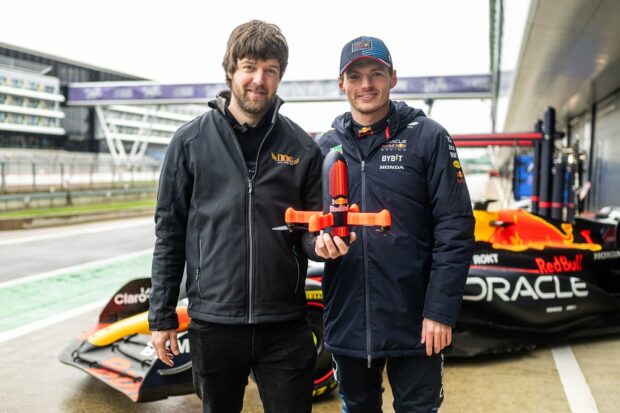Drone masterminds have taken DIY engineering to the next level with the first drone capable of keeping up with an F1 car on the track. Here’s how they created it.
A decade ago, when he was around 25 years old, Ralph Hogenbirk – aka Shaggy – first got into the world of drones. Back then, it was a hobby alongside his office job. But, as drone tech rapidly took off, so too did Hogenbirk’s involvement. From building drones to competing in the Drone Racing League to eventually filming Red Bull Valparaíso Cerro Abajo in 2020, Hogenbirk’s career has been picking up speed.
Now, together with the whole of the Dutch Drone Gods team, he’s topped it all by building a custom FPV (first-person view) drone that can actually keep pace with Red Bull’s brand new F1 car, the RB20, around a full Grand Prix lap at the UK’s Silverstone Circuit.
The challenges on the road to building such an aircraft were monumental. The team had to ensure it could rival an F1 car in its acceleration and deceleration around turns, pack a battery that would be able to fly flat out around an 5.8km circuit, plus make sure that it could handle sustained power without bursting into flames. Oh, and then there was only the final challenge of learning how to fly a completely new drone and keep up with a F1 multiple world champion.
From conception to lift-off, here’s what it took to get the project off the ground:
You’ve been working on this project in secret for some time now. How did it come about?Shaggy:
It started about a year ago when Red Bull contacted me saying ‘Hey, we have this idea…’ They’d been thinking about it for a while, the idea of having a drone that could follow a Formula One car for an entire lap. The speed was never the problem, there are drones that could keep up on the straight, but the corners were an issue.
This has to be a really exciting commission, but also a really complex one. What were the first things you discussed with your team?
My two colleagues and I immediately began brainstorming: ‘What can we do? What should this drone look like? What’s been done before?’ We knew of a few attempts at building fast drones that went to around 370kph, but these were all very slim rockets and they were only made to go fast once. They were super-light with small batteries and no recording equipment. That wouldn’t work for us. It meant that we knew the speed was possible, but we didn’t know if it was possible to add filming equipment and also be able to handle corners. The question was: ‘How would we control something like that in the air?’
How did previous drone designs influence yours?
Our initial thought was that aerodynamics is the biggest factor in this, not necessarily weight. We knew that if we could make something that’s super-aerodynamic and super-efficient, we could also make the batteries last longer. The second tactic was not to go for the top speed, but to focus on endurance as well. From battery to motors to propellers, we wanted everything to operate just below their limits so it was very efficient and wouldn’t overpower the drone.
Did you take any design cues from Oracle Red Bull Racing’s F1 cars?
No, they behave so differently. Maybe there are some general aerodynamics aspects like the design or shape, but it’s such a specific machine that there isn’t much from a Formula One car that applies.
How much of the hardware is new and how much was adapting existing components?
The electronics and the motors are pretty standard, off-the-shelf components, but we spoke to the suppliers asking for their latest, unreleased hardware. For example, we needed something that could handle more RPM for the motor, and they had it. It was reasonably off the shelf with maybe a few unreleased parts, but then the whole outer structure of the drone itself was designed from the ground up by us. We did a lot of 3D printing, for both prototyping and for the final product as well. And there’s some carbon CNC stuff that we did as well ourselves, too.
You’re not able to discuss specific components, but can you share some stats on just how awesome this drone is?
Yes, so the top speed is 350kph, an acceleration of 100-300kph in just two seconds (most F1 cars accelerate from 0 – 60mph [97kph] in roughly 2.6s). This generates 6G at max load, with a 2-3G average acting on the carbon, glass fibre and 3D polymer body. Weight was obviously important and we managed to get it down to under 1kg in weight. I’d like to get the camera capabilities to be able to livestream, but it still works well with a 4k60fps / 5k30fps camera with 10bit colours
David Coulthard said: “I just see the potential, there are so many applications to really give the viewer the feeling of what it’s like to be in one of these race cars.” What would you say to people who are interested in drones and are inspired by what you’ve done?
Try to think outside the box. There are a lot of things in the FPV community that are just taken for granted. All FPV pilots, we all fly with three blade propellers, for example. But no one’s really questioning if that’s the best solution. But, you know, if you really think about why something is used, the ways used, there’s a lot of things in the drone scene that you can have a scientific and calculating response to. OK, what is actually the best solution? And then just start testing. Don’t assume that we’ve done this thing for so long, and it’s proven to be right, so that’s how it has to be.
Top Photo: Ralph Hogenbirk, the Rocket Drone and Max Verstappen – © joerg Mitter/Limex Images
Source: Red Bull





